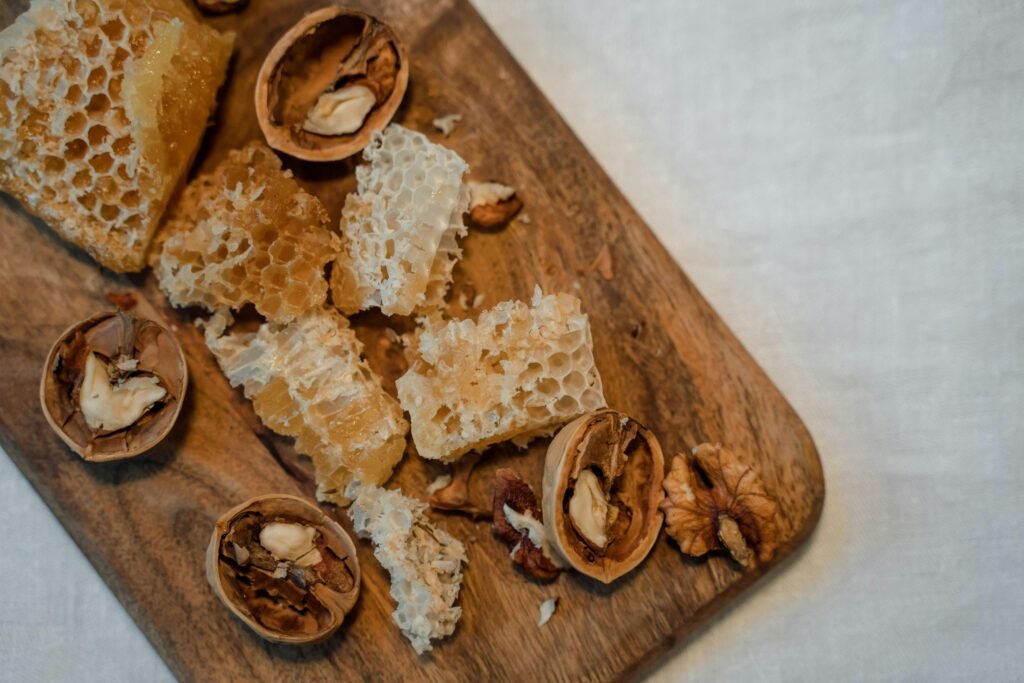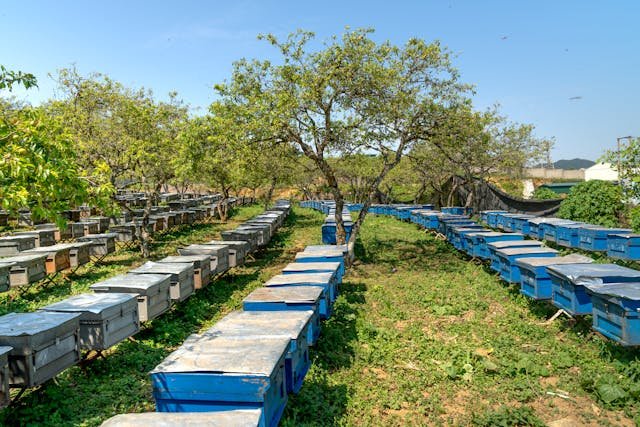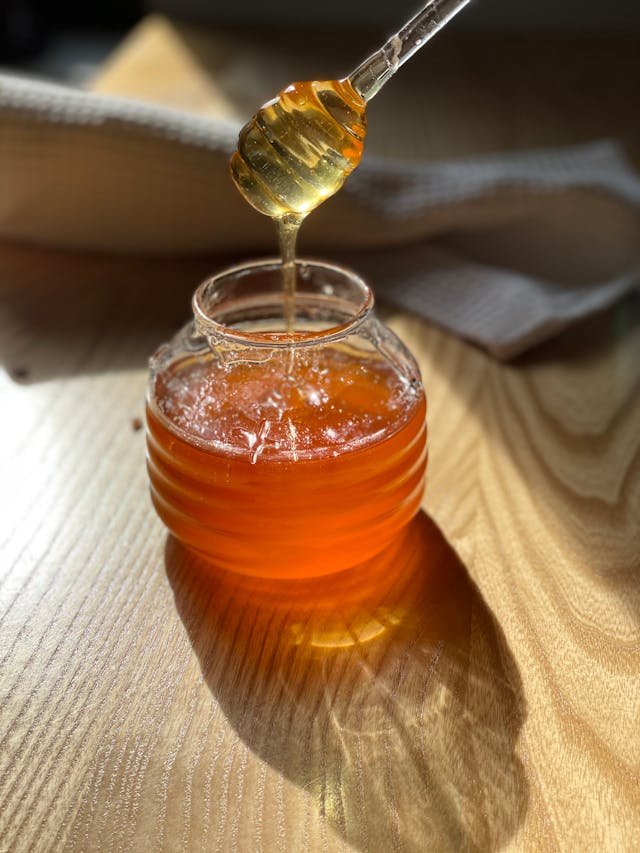Tupelo honey is a rare monofloral type. It comes from the White Tupelo tree in the Apalachicola River Basin. Learn why beekeepers love it!
Introduction
Tupelo honey is a rare and special type of honey. It comes from the White Tupelo tree (Nyssa ogechee). It grows in Florida’s Apalachicola River Basin. This honey is unique because it is made mostly from one flower, so we call it monofloral honey. Beekeepers work hard to collect this honey during the short blooming season.
This blog will discuss what makes Tupelo honey unique. We’ll cover its sweet taste, health benefits, and how it is harvested. We will also compare Tupelo honey to other types of honey to show why it is so special. Join us as we explore this delicious honey!
What is Tupelo Honey?
Tupelo honey is a unique variety of honey made from the nectar of White Tupelo trees (Nyssa ogechee). These trees thrive in the Florida Panhandle, particularly in the Apalachicola River Basin. This region is perfect for the trees to grow. It has the right conditions for bees to gather nectar.
Tupelo honey is monofloral, meaning it mainly comes from one flower type. This gives it a special taste and high quality, making it highly regarded among honey lovers
Tupelo Honey Production Process
Harvest Season for Tupelo Honey
Tupelo honey is harvested in late April to early June. This is when the White Tupelo trees are in full bloom. Beekeepers closely monitor the hives as the bees gather nectar from the blossoms. The honey is collected carefully to ensure its purity and unique flavor. After harvesting, it is usually filtered and bottled, maintaining its natural qualities. This timing is crucial for getting high-quality Tupelo honey. It must retain its unique taste and qualities.
Importance of Environmental Factors and Challenges for Beekeepers
Environmental factors are crucial for successful Tupelo honey production. Weather, such as temperature and rain, affects White Tupelo trees. It impacts their bloom and nectar availability.
Beekeepers face challenges. They must manage bee health, protect against pests, and adapt to climate change. These factors can impact bee populations and honey yield. Also, pollution and habitat loss can harm the flowers bees need. So, it’s vital for beekeepers to use sustainable methods. They must ensure a healthy environment for their bees.
The Role of the White Tupelo Blossom and Beekeeping for Honey Purity
The White Tupelo blossom is vital for producing Tupelo honey. It provides the nectar that gives this honey its unique taste and characteristics. For beekeepers, a healthy supply of these blossoms is vital for pure honey.
To protect honey quality, beekeeping practices are key. They include regular hive inspections and avoiding contamination. This care keeps the honey true to its source. It lets consumers enjoy its unique flavor and benefits.
Unique Characteristics of Tupelo Honey

Distinct Sweetness Profile
Tupelo honey is famous for its sweetness. It has a high fructose-to-glucose ratio. Typically, this honey has about 70% fructose and only 30% glucose. This balance helps prevent crystallization. It keeps the liquid smooth for longer. Many honey types may crystallize within six months. But, Tupelo honey can stay liquid for up to two years or more if stored properly. This characteristic makes it a favorite for many honey lovers.
Golden Color and Unique Floral Notes
Tupelo honey is known for its beautiful golden color, which can range from light amber to a deep, rich hue. Its unique floral notes come from the White Tupelo tree. It gives the honey a distinct flavor. It has a mild sweetness and fruity hints. This sets it apart from other honeys. This unique taste and color make Tupelo honey a gourmet choice for honey lovers.
Tupelo Honey vs Other Types of Honey

Manuka Honey vs. Tupelo Honey: Key differences in flavor, texture, and health benefits.
Feature | Manuka Honey | Tupelo Honey |
Flavor | Strong, complex, earthy | Mild, sweet, and floral |
Texture | Thick and creamy | Smooth and liquid |
Health Benefits | Antibacterial, wound healing | Antioxidant-rich, supports immunity |
Fructose/Glucose Ratio | Balanced, lower fructose | High fructose-to-glucose ratio |
Crystallization | May crystallize | Resists crystallization |
Production Area | Primarily New Zealand | Florida Panhandle, USA |
Price | Generally more expensive | Moderately priced |
Raw vs Processed Honey
How Tupelo honey’s natural qualities differ from processed honey.
Feature | Raw Tupelo Honey | Processed Honey |
Processing | Unprocessed, comes directly from the hive | Filtered and heated |
Nutritional Value | Nutrient-rich, contains enzymes and antioxidants | Nutrient loss due to heating |
Flavor | Retains unique floral taste and aroma | More uniform flavor, may lose distinct notes |
Crystallization | Less prone to crystallization | More likely to crystallize |
Crystallization:
Tupelo honey is known for its high fructose-to-glucose ratio, which is approximately 1.5:1. This ratio is higher than many other honey types. Clover and wildflower honey can have ratios closer to 1:1. The high fructose content prevents crystallization. It keeps Tupelo honey smooth and liquid for a long time. Clover honey crystallizes in 6-12 months. Wildflower honey can crystallize in 3-6 months. Tupelo honey’s unique property makes it a top choice for a long-lasting, versatile sweetener.
Uses and Benefits of Tupelo Honey

Common uses: Cooking, baking, gourmet dishes, and as a premium sweetener.
Tupelo honey is a highly versatile ingredient that shines in various culinary applications. Its sweet flavor and distinct floral notes make it a favorite among chefs and home cooks alike.
- Cooking: Tupelo honey can elevate savory dishes. In marinades or glazes, just 1-2 tablespoons can balance the flavors perfectly. Its unique sweetness complements meats like chicken and pork, enhancing their natural flavors.
- Baking: In baking, Tupelo honey excels due to its moisture-retaining properties. Replacing regular sugar with Tupelo honey can lead to softer cakes and cookies. For example, using 3/4 cup of honey can replace 1 cup of sugar, reducing the dryness that often occurs in baked goods.
- Gourmet Dishes: Chefs frequently use Tupelo honey in gourmet sauces and dressings. Its rich flavor can elevate dishes. So, it’s perfect for salad dressings. Just a tablespoon adds a delightful sweetness and complexity.
- Premium Sweetener: Tupelo honey has 40% fructose. It has a lesser glycemic index than regular honey. So, it is a better sweetener for teas and smoothies. This means it sweetens effectively without causing rapid spikes in blood sugar levels.
Health Benefits:
Tupelo honey is not just a sweetener; it also contains antioxidants. Eating it regularly can boost your health. So, it’s a smart choice for anyone wanting to improve their diet.
In summary, Tupelo honey is a tasty sweetener. It also boosts many dishes. Its distinctive properties and health benefits make it an important addition to any kitchen.
Health Benefits of Tupelo Honey
Tupelo honey is a tasty sweetener. It also has many health benefits. So, it’s a good addition to your diet.
- Tupelo honey is rich in antioxidants, like flavonoids and phenolic acids. These compounds help fight oxidative stress. It can damage cells and cause chronic diseases. Antioxidants can reduce heart disease risk and boost health. They support the immune system.
- Low Glycemic Index: The glycemic index (GI) determines how fast a food raises blood sugar. Tupelo honey has a low GI of about 30. It raises blood sugar more slowly than regular sugar, which has a GI of about 65. This makes Tupelo honey better for diabetics. It is also good for those who want stable energy all day.
- Gluten-Free: As a natural sweetener, Tupelo honey is gluten-free. It is a good option for those with gluten sensitivities or celiac disease. It can be added to many recipes. This lets those on gluten-free diets enjoy its unique flavor without worry.
- Natural Energy Source: Tupelo honey has simple sugars, like fructose and glucose. They provide an instant energy boost. Athletes often use natural honey for a quick energy boost before or after workouts.
- Soothing Properties: Tupelo honey soothes sore throats and coughs. It’s been used for this effect for a long time. Its natural antibacterial properties can help fight infections and promote healing.
Why Tupelo honey is considered one of the best honey types.?
Adding Tupelo honey to your diet can improve your health and meals. Its ample benefits make it a great choice. Drizzle it over yogurt, mix it into tea, or use it in baking for a healthier lifestyle.
Tupelo honey is regarded as one of the best types of honey due to its distinct qualities. Its flavor is uniquely floral and sweet, with a light taste that many find delightful. The honey comes from the nectar of the White Tupelo tree (Nyssa ogeche). It grows in the Apalachicola River Basin. This makes it rare and premium.
Tupelo honey has a low glycemic index. So, it is a healthier option to refined sugars. Its high fructose-to-glucose ratio helps it resist crystallization. So, it stays smooth and liquid longer than other honey types. This quality boosts its usability in cooking. It also keeps its natural flavor.
Additionally, Tupelo honey is rich in antioxidants, which contribute to overall health benefits. These antioxidants help the body. They fight oxidative stress, boost immunity, and lower inflammation. Its gluten-free nature also makes it idle for individuals with gluten sensitivities.
Tupelo honey’s unique traits make it a premium gourmet honey. Its rare production and unique growing needs raise its value among honey fans and chefs.
Challenges in Tupelo Honey Production

Decline in production due to environmental risks and sustainability concerns.
Tupelo honey production is increasingly threatened by various environmental and sustainability challenges. A major issue is the decline of White Tupelo trees (Nyssa ogeche). They are vital for producing this unique honey. Urban development and climate change cause habitat loss. This decline makes it harder for bees to find vital food sources.
Impact of pesticide use and other factors affecting bee populations
Pesticide use also poses a serious risk to bee populations. Agricultural chemicals can harm bees. They affect bees’ health and pollination. This, in turn, impacts the yield and quality of Tupelo honey. Studies show that pesticides can reduce bee populations by up to 30%. This, in turn, hurts honey production.
How sustainable beekeeping can help protect this rare honey
To combat these challenges, sustainable beekeeping practices are crucial. Beekeepers can help bees and biodiversity. They should reduce pesticide use and improve bee habitats. Also, community support for local ecosystems is vital for the future of Tupelo honey.
Investing in sustainable practices protects ecosystems. It also ensures the quality of this premium honey. Focusing on local plants, responsible land use, and less chemicals can help bees. It can also create a more sustainable honey production system. These efforts can help ensure Tupelo honey is a cherished, available product.
Where to Find Tupelo Honey
To find high-quality Tupelo honey, follow these guidelines:
Local Markets: Check out local farmers’ markets. Many beekeepers sell their products directly, ensuring freshness and authenticity.
Specialty Stores: Visit gourmet food shops and health food stores. They often stock unique honey varieties, including tupelo.
Online Shopping: Explore online retailers. Websites like Amazon and Thrive Market sell trusted brands of Tupelo honey. They offer convenient home delivery.
Brand Reputation: Find honey from the Florida Panhandle and the Apalachicola River Basin. They are known for the best Tupelo honey. Sustainable brands help local beekeepers and protect the bees.
Final Words
Tupelo honey is a rare variety. Its unique traits make it exceptional. It comes from the White Tupelo tree (Nyssa ogechee). It thrives in the rich Apalachicola River Basin ecosystem. This honey has a high fructose-to-glucose ratio. It prevents crystallization and gives it a smooth texture.
The golden hue and delicate floral notes add to its allure, making it a favorite among honey lovers. Also, Tupelo honey has health benefits. It’s gluten-free and has a lower glycemic index. So, it’s a healthier alternative to processed sweeteners.
Tupelo honey is a premium product. Its production is limited, and beekeepers face environmental challenges. Its unique flavor, health benefits, and rarity make it a top honey.
We must support sustainable beekeeping. It’s vital for bee populations and the environment. Sustainable methods help bees thrive. This boosts honey production, including rare types like Tupelo honey. These practices help preserve biodiversity and promote pollination. They also reduce reliance on harmful pesticides. Sustainably sourced honey supports beekeepers who care for their bees and the ecosystem. This helps the bees. It also ensures high-quality honey for future generations.
Frequently Asked Question (FAQ)
Why is Tupelo honey considered a premium honey? Its limited production, unique flavor, and health benefits make it premium. The careful harvesting and the challenges of beekeeping add to its value.
Where can I find Tupelo honey? You can find Tupelo honey at specialty stores, farmers’ markets, and online. Choose brands that value quality and sustainability. This will ensure you get pure Tupelo honey.
What are the health benefits of Tupelo honey? Tupelo honey is rich in antioxidants, has a low glycemic index, and is gluten-free. It is a healthier sweetener than regular sugar and some honeys.
How does Tupelo honey differ from other honey? It has a higher fructose-to-glucose ratio, so it is less likely to crystallize. Its unique floral notes and golden color also set it apart, along with its origin from a specific type of tree.
Why Tupelo honey is considered a premium, gourmet honey compared to regular types?
Tupelo honey is a premium, gourmet honey. Its unique flavor is sweeter and less likely to crystallize than regular honey. It has a high fructose-to-glucose ratio. This gives it a smooth texture and a long shelf life. Its rarity comes from the specific conditions in which it is produced. It is made mostly from the blossoms of the White Tupelo tree in the Apalachicola River Basin. Also, its monofloral nature means it has distinct floral notes. Many honey fans appreciate these.



